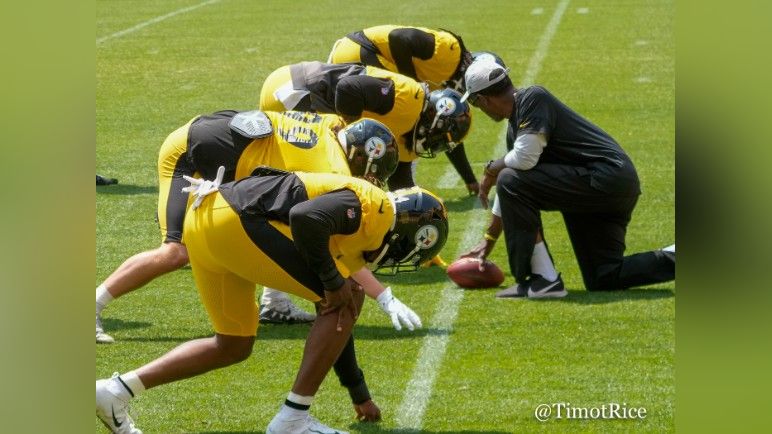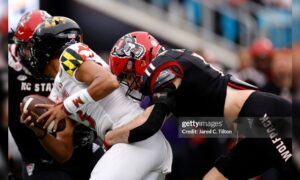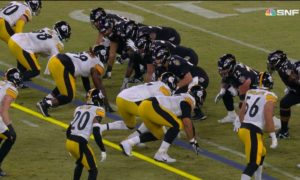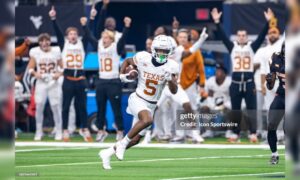Want a hot take? If Stephon Tuitt and Tyson Alualu had both been healthy, this team would have been 3-6 wins better with no other changes at all. Here’s the argument in a nutshell:
1. The 2021 run defense stank because it requires 2 1/2 quality DT’s, and Pittsburgh played most of the season with 1 star (Heyward), one often-injured pro (the improved Wormley), and a bunch of guys valiantly trying to achieve a professional standard.
2. Tyson Alualu alone would have made this run defense respectable. That would have made the required 2½.
3. Stephon Tuitt alone would have made this run defense good and the pass rush a good deal better. Same, but with a second real star in the mix.
4. Stephon Tuitt and Tyson Alualu, together, would have made this run defense complete; over quota for players and packed with all pros. This would have in turn would have directly helped the pass rush better, and aided the pass coverage too by making opponents predictable.
Bottom line? Cam Heyward is the beating heart of Pittsburgh’s defense, but if you look at the numbers and the film, Tuitt is even better on the field. Tsk tsk, tut tut, and shame on us. Stephon Tuitt deserves a lot more respect than he’s been getting, and his loss a lot more credit for this year’s problems.
Think I’m overstating the case? Let’s go through a quick primer on how the Steelers’ modern run defense works, and how these injuries cascaded through the entire unit.
Everything starts in the trenches
Run defense, and in reverse the running game offense, is all about who controls the gaps and angles. In the biggest picture, you can say that when the offense takes control of a gap (opens a hole), the running play is likely to end in one of those quality 5-10 yard gains, with occasional bursts for more if there’s a second issue in the box and/or secondary. If the defense penetrates a gap, it results in stuffed runs and drive-killing tackles for loss (“TFL’s”). If the two sides tie, you get those 2-3 yard gains.
Simple enough. Add in the fact that running success (or lack of it) controls what personnel the defense can play, how many people it requires in the box, and the defensive play calls. This will get you to the TV analyst level of sophistication.
But let’s dig a little deeper. Imagine the O-Linemen as moving fence posts holding hands, that want to move forward as a unit. The “gaps” are those weak spots where there’s only hands. The “A gaps” are the ones between the Center and the Guards; “B gaps” between the Guards and the Tackles; and “C gaps between the Tackles and the TE’s.
Defenses try to control those gaps in two ways. The most common, and the current Steelers favorite, asks the D-Linemen to penetrate through those gaps by virtue of their speed, strength, and explosive burst. This is called “1-gapping”. The classic LeBeau-era defense asked the DL’s to instead focus on holding the fenceposts in place. Stopping the OL in place gave the ILB’s clear paths to tackle almost at will. This is “2-gapping.”
Either way, each D-Lineman has a designated spot along the line that he is supposed to either dominate (1-gapping) or control (2-gapping). This is that DL’s “fit.” On paper the image often looks like someone plugging holes in the offensive net. The ILB’s and Box Safeties float along behind at the second level, watching for where the cracks develop. If the DL wins, the crack opens access to the backfield for that TFL. If the DL loses, the ILB gets blocked. If the DL achieves a tie… you get the point.
All run defense starts with the DL holding its own, and no run defense can survive if the DL fails to at least break even.
[DIGRESSION: NFL running backs are freaks of nature, especially when it comes to “vision.” The good ones have almost superhuman ability to see even a tiny weak spot instantly, and to teleport into that spot with enough power and burst to either strain or sever the defensive net. One cannot understand the challenge facing an NFL run defense unless you start with the idea that your ball carrier will almost always make the defense pay for doing too much, doing too little, or even doing the right thing in less than a perfect way.]
Next, what actually happens to cause a defensive win when a man like Heyward or Tuitt gets penetration? Take that image of a net and bend it backward into the RB’s path. (A) He needs to avoid the threat, and (B) his blockers have been thinned out from a line to a bulge. That opens a hole for the ILB to shoot in to the backfield. The RB sees that hole too, but he can’t really use it because the D-Lineman can easily step back into the RB’s path (unless the OL grabs hold and pulls of course, which is one reason why that penalty gets called so often). Besides, even if the RB could get past the lineman, he’s likely to meet that ILB on the offense’s side of the line of scrimmage. That results in little or no gain unless we’re talking about Barry Sanders himself.
The offense’s wins come in two ways. (A) The offensive line may wedge a defender out of place, or (B) a defender may read the play wrong and voluntarily head toward the wrong spot. Remember hearing all that maddened hair pulling and angst about the need for “gap discipline”? That’s “B,” and it’s actually more common that “A”.
[DIGRESSION: Have you ever read scouting reports/discussions that go on about the prospect’s ability to “understand the defense,” “read the keys,” “read and react,” and “trigger from see to do?” This is what they’re referring to. ILB’s and Box Safeties need to know what holes may open up against X, Y, or Z offensive plays; read and analyze which scenario they’re in ASAP; and then fire into the right spot as required for that scenario. Making the tackle when they get there is just the end of a longer, more intricate, and more important set of decisions. More important because just getting there is enough to stall the play and allow time for other defenders to rally toward the ball.]
The “A” problem is what you typically think of. The O-Lineman wins, a hole opens, the RB hits that hole before the ILB, thereby gaining 5-8 yards because the defender had to drag him down from behind or underneath. Or more, if the tackle gets missed or the ILB couldn’t get there.
Summing up: NFL run defense requires good gap discipline and Defensive Tackles who can hold their place well enough to avoid a loss. Great run defense happens when gap discipline combines with DT’s who either penetrate the OL (1-gapping), or hold it frozen in place (2-gapping). Weak run defense results from bad gap discipline, which can be heading to the wrong spot, getting there late, or overrunning the gap to leave that genius RB a lane for the cut-back.
Why the 2021 run defense became a debacle
What happened to Pittsburgh’s DL in 2021 was another level worse than “weak.” Go back to that image of the running play match between DL and OL, and then ask yourself this question: What happens if a Defensive Tackle gets blown off the line so badly that he runs into the pursuing ILB? Or sideways into one or more of his fellow D-Linemen?
Chaos and disaster, that’s what. You end up with one OL effectively blocking two or even three defenders all on his own, and thereby freeing other blockers to pursue additional defenders. And that is what happened in all those 2021 games where opponents ran over the Steelers defense at will. The defensive line lost in the trenches, which forced the ILB’s and Safeties to fill extra-large gaps several yards downfield against RB’s with a head of steam up, and often an extra OL bearing down to share a few cents of his own opinion. Football people have an acronym for the second level defenders who face that problem. We use it in everyday life as well. “SOL.” The 2021 defense in a nutshell, at least until Adams arrived and Wormley go healthy enough to make it NFL-average.
The midseason DL simply ran out of competent players
Getting back to the point, here’s where you need those 2-3 competent DT’s. Going into 2021:
- Heyward was more than competent. He not only holds his own, he wins more than his fair share. CHECK.
- Tuitt was more than competent, and would win just as many as Cam. PLAYER LOST.
- Alualu was very competent, and would almost never lose. PLAYER LOST.
- We hoped that Wormley would be competent, which he was. PLAYER OFTEN HURT.
- We hoped that Carlos Davis would be competent. PLAYER LOST.
- We hoped that Isaiah Buggs would be competent. PLAYER LOST TO FAILURE AND INJURY.
Yikes. That left only the emergency depth.
- Loudermilk was supposed to have a redshirt year with occasional snaps for experience. PLAYED LIKE A PROMISING ROOKIE, WITH LOTS OF TIES AND OCCASIONAL LOSSES.
- Mondeaux is a special teams guy who only technically plays on the DL. PLAYED VALIANTLY, TYING AND LOSING EQUALLY.
Just to drive the point home even harder, go back and think about the reaction when the team traded away its 2022 4th-rounder to pick Loudermilk in the 5th round of 2021. In a word, that decision was met with a universal“What?!” The team answered, “he is a really promising body type that looks like Cam Heyward. Raw as heck, but we’ll give him a redshirt year to grow and might well have a diamond in the rough for 2-3 years from now when the current stars start to decline.”
Okay… Pretty steep price for a far-seeing projection, but the F.O. knows its business better than we do.
What happened by Weeks 10-12? “Oh no! Loudermilk is dinged up too? How can we ever survive?!” In other words, by mid-season the guy on his redshirt year was considered absolutely essential in order to simply field a complete roster. I’m not denigrating the young man. Quite the opposite. He played better than we had any right to expect. But the idea that he needed to play? That’s a defense in biiiiiiiig trouble.
Wait… Did that horse corpse just twitch? I think it might have. So let’s go kick it a final time. What was happening before the ultra-emergency redshirt guy started to miss a few games? The team literally had only three theoretically-capable D-Linemen on the entire roster, including him! Heyward, the rookie, and Mondeaux! Even Cam needs to rotate out occasionally. The state of affairs got so dire that the F.O. resorted to other teams for their practice squad depth. That was why, in Week 13 (five games remaining!) of the season, they made a desperate reach in order to snitch a career-stalled journeyman named Montravius Adams from the Saints.
Adams played better than advertised, too. He turned out to be a competent journeyman, not a stalled one, and managed to achieve a lot of ties with only the occasional loss. He even got a win or three mixed in. But don’t miss the big picture point. Things had to be catastrophically awful for simple competence to be greeted like the second coming. And it was.
I don’t mean to pick on the young men who couldn’t handle the task, except maybe for Buggs. He was the only one who played below my preseason expectations. The point is that Pittsburgh’s DL situation in 2021 made the term “dumpster fire” look like a longed for fantasy. So let’s close this out by circling back to that lens of what a run defense looks for: gap discipline, plus mano-a-mano wins, ties, and losses. In 2021 Pittsburgh had:
- 1 STAR: Good gap discipline + mostly wins or ties, very rare losses.
- 1 STARTER (OFTEN BROKEN): Good gap discipline + occasional wins, mostly ties, rare losses.
- 1 ROOKIE: Poor gap discipline + very rare wins, mostly ties, lots of losses.
- 1 SPECIAL TEAMER: Good gap discipline + no wins, mix of ties and losses.
- 1 JOURNEYMAN (AFTER WEEK 13): Developing gap discipline + rare wins, mostly ties, rare losses.
The result, especially when that starter (Wormley) was limited and before the journeyman (Adams) caught up to the train?
- No big defensive plays against the run;
- Hope to achieve those 2-3 yard ties;
- A regular diet of 6-10 yard defeats;
- The occasional 20-30 yard gashes; and thus
- Ranking as the worst run defense in the league.
The point? Add Alualu back into the picture, or even better Tuitt, and everything would have improved by a notch: We would have seen:
- A thin but healthy diet of run-stuffing TFL’s;
- A great majority of everyday ties;
- Rare runs for those 6-10 yard defeats;
- Almost none of those humiliating gallops; and thus
- Run defense somewhere toward the top third of the NFL.
Add in both Alualu and Tuitt? You get what we hoped for when the season began. A #1 defense that could have carried the team while the offense struggles through as big a reloading as any in the past few decades.
Team defense begins on the defensive line. Injuries cost us our defensive line. Everything else went downhill just as you’d predict. Shame on us for ignoring just how important a guy like Stephon Tuitt really is.
[END OF TIRADE]. Sorry for running on so long. I’ve been holding this back for a great many weeks. But there is good news if we look through the windshield instead of the rear view mirror.
A LOOK AT THE 2022 DEFENSIVE LINE:
Defining Terms:
- DE1 and NT1 refer to someone who is a star.
- DE2 and NT2 refer to a starter-quality player who is not a star.
- TOMLIN’S “LINE”
- DE3 and NT3 are backups.
- DE4 and NT4 are break-in-case-of-glass emergency players.
- All our NT’s can play at DE too, but at a grade down the scale. Which is good, since pure NT’s can be schemed off the field at will by the offense.
DE1: Cam Heyward will be back next year. He’ll be 33, but has shown no signs of slowing down.
DE1: Stephon Tuitt…? We don’t know what kept him out, and we don’t know if he’s ever coming back.
DE2: Chris Wormley. When healthy, Wormley played his best football ever in 2021. Call it Heyward or Tuitt on a bad day, which says a lot about how good those two really are. Under contract for 2022.
DE3: Isaiah Loudermilk. Maybe even a DE2 if all goes well, but let’s not assume what we only have a right to hope? The F.O. was one step ahead us, yet again. Bound to be better after an offseason of training in both strength and technique. Fans need to remember that it took both Heyward and Tuitt 2-4 years before they really arrived, and have continued to improve into their 30’s. We should be ecstatic if Loudermilk follows their path.
NT1/2: Alualu…??? I went into this offseason expecting Alualu to retire. He’s about to turn 35, he’s coming off a scary injury, and what does he need to prove? On the other hand, he has expressly said that he plans to return. Time will tell. He has even less need to lie about returning than he does to prove his career a success.
NT2/3: Carlos Davis. Under contract, but can he stay healthy? He straddled the Tomlin Line when healthy. Can he get better?
NT2/3: Montravius Adams. A former Round 3 pick who’s struggled to get off various practice squads, Adams played like a proper journeyman once he settled here in Pittsburgh. Pretty much at the same level as a healthy Davis imho. He will also be a solid NT2 if he can cement he technique to avoid the occasional blunders. Star NT1 who’d serve as an heir to Alualu and Hargrave? Not so much.
NT/DE4: Henry Mondeaux. I like Mondeaux but his primary value is on special teams where his superior athleticism compensates for his lack of the size and oomph to be a reliable piece of the D-Line puzzle
THE THREE DRAFT SCENARIOS.
If all of that is correct, we have three situations that may be in play come April.
In Scenario 1, both Alualu and Stephon Tuitt return healthy and eager. The unit is set and basically off the board.
In Scenario 2, Alualu retires but Stephon Tuitt returns healthy and eager. The unit is a team strength, especially if one of the backup NT’s can mature. Maybe a Javon Hargrave bargain if he falls to Round 3 or 4? The names I plan to research more carefully are:
- ROUND 3 – DT Travis Jones, Connecticut. (Junior). 6’4”, 328 lbs. He’s a little bigger and stronger than Hargrave was, and a little less explosive, but the underlying story is much the same. Small school titan who dominated against lesser talent, was a major team leader, and should be able to succeed at the NFL level once he gets his full, grown man powers and discipline in place. I have a good hunch about this prospect, FWIW.
- ROUND 4 – Keeanu Benton, Wisconsin. (Junior). 6’3”, 320 lbs. Same basic model with a lower ceiling and better experience. This is a grade that may change in significant ways as the process moves forward. I’m not particularly comfortable with even that summary.
In Scenario 3, Tuitt hangs up his cleats right beside Alualu’s. That loss would hurt, but the unit would still be solid. The growth we saw in Wormley and Loudermilk would prevent any panic. An extra body would be needed, however, ideally one who could do double duty as both a DE and a NT. The names to look up are:
- ROUND 1 – DT/NT Jordan Davis, Georgia. (Senior). 6’6”, 340 lbs. Could be the next coming of Casey Hampton if his coaches can keep him revved up, working, and disciplined. He isn’t just an immovable object. He regularly tossed both Centers and Guards back into the QB’s lap on passing downs. That counts as “pass rush” my friends, even if he isn’t getting those monster mitts onto the QB’s frame.
The thing is, I don’t see a way for this pick to happen. Davis will go before the Steelers Round 1 pick if the process reveals a good motor and the ability to stay in shape. And Pittsburgh wouldn’t take him even in Round 2 if they question that motor. It’s hard to see a situation where he would be both available and desired.
- ROUND 2 – DT Phidarian Mathis, Alabama. (RS Senior). 6’4”, 317 lbs. About as pro ready as they come, but my initial impression is that he’s a bit of a fish-or-fowl prospect from our POV. Can he do all that Pittsburgh would want, or is he more of a pure 4-3 3-tech? He will also be a 23 year old rookie, which raises flags because Pittsburgh loves to pick them young.
- ROUND 2 – DT Devonte Wyatt, Georgia. (Senior). 6’3”, 315 lbs. Jordan Davis got the bigger press, but Wyatt may have quietly been the better of Georgia’s two DT stars. He’s more explosive off the snap, and is therefore easier to project as a pass rushing asset. But he also faces many of the same question marks as Mathis. Is he just a quality 3-tech prospect? Or can he do all that Pittsburgh’s scheme would require? Also likely to rise toward the late 1st or early 2nd, between the Steelers’ picks.
- ROUND 3 – DT Travis Jones, Connecticut. (Junior). 6’4”, 328 lbs. See above.
So? What do you think of my analysis? Please let me know in the comments.








